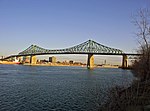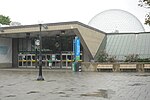Fort de l'Île Sainte-Hélène

The Saint Helen Island Fort (French: Fort de l'Île Sainte-Hélène), a historic site on Saint Helen's Island in the city of Montreal, Quebec, was constructed in the early 1820s as an arsenal in the defensive chain of forts built to protect Canada from a threat of American invasion. Although not heavily fortified, it served an important purpose as the central artillery depot for all forts west, and in the Richelieu River Valley, known as the Valley of the Forts. These included Fort Henry and Fort Lennox. The red stone used to build the Fort is a breccia quarried on the island, which is situated in the St. Lawrence River between the island of Montreal and the south shore. The Levis Tower, contrary to popular belief, was not part of the fortifications on the island. It was built in the 1930s to house a water tower.
Excerpt from the Wikipedia article Fort de l'Île Sainte-Hélène (License: CC BY-SA 3.0, Authors, Images).Fort de l'Île Sainte-Hélène
Chemin de La Ronde, Montreal Ville-Marie
Geographical coordinates (GPS) Address Nearby Places Show on map
Geographical coordinates (GPS)
| Latitude | Longitude |
|---|---|
| N 45.5197 ° | E -73.536 ° |
Address
Fort de l'île Sainte-Hélène
Chemin de La Ronde
H3C 6A3 Montreal, Ville-Marie
Quebec, Canada
Open on Google Maps









